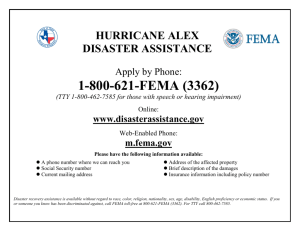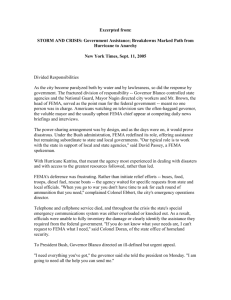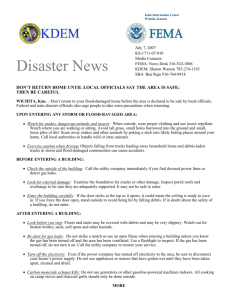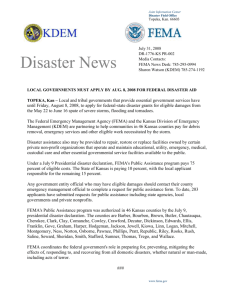Katrina PADM 524 consolidated lecture
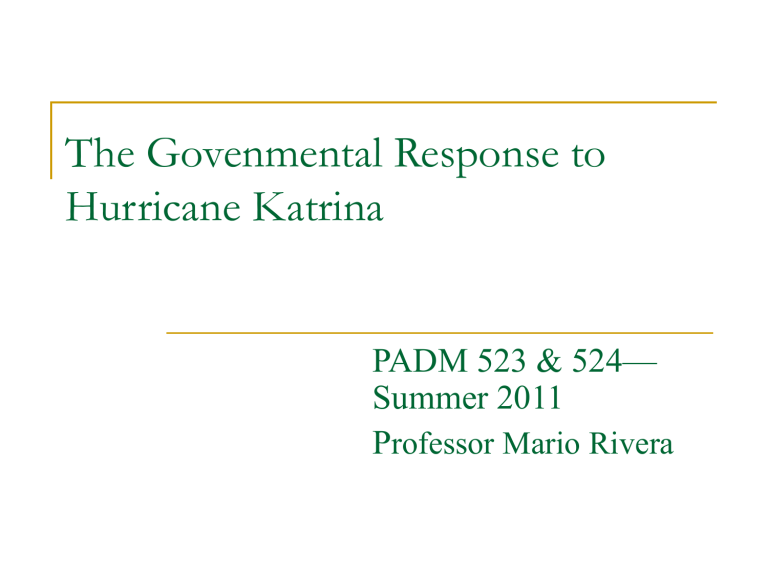
The Govenmental Response to
Hurricane Katrina
PADM 523 & 524—
Summer 2011
P rofessor Mario Rivera
Layered and sequenced Response Strategy
State Response
Regional / Mutual Response Systems
Local Response, Municipal and County
Minimal Low Medium High
Increasing magnitude and severity
Federal Response
Catastrophic
Federal-State-Local Relations and Katrina
Louisiana Governor Blanco had requested “emergency protective measures, [in particular] direct Federal
Assistance.” The governor was frustrated that FEMA’s Brown wanted itemized requests, and that, in general, she could not get the “feds” to respond. Her appeal: “Mr. President, we need your help. We need everything you've got.”
While Blanco may have over-relied on a federal response that was slow to come, she also exhibited great reluctance to federalize the state’s response to Katrina, specifically in her refusal federalization of the Louisiana National Guard.
Brown seemed to rely overmuch on the layered and stagewise response to major emergencies envisioned in FEMA protocols and in the National Incident Management System.
New Orleans Mayor Ray Nagin
Nagin complained that federal officials “don’t have a clue what’s going on down here.” He complained that Bush and
Blanco could not come to agreement concerning the federal role (For his part, Brown blamed Nagin and Blanco for their disagreements). Blanco blocked Nagin’s belated compulsory evacuation order until that kind of evacuation became inevitable. The Red Cross was stymied by Blanco as well. She barred them from access to the city on the grounds that it was not safe to approach the Superdome.
Was Blanco’s reticence toward the President justified? Some see Blanco exhibiting the so-called “fundamental attribution bias” toward Bush, personalizing their interaction and projecting nefarious motives to him re ‘her’ National Guard.’
Limits on the use of the U.S. military
The Insurrection Act of 1795 permits the use of federal troops on U.S. soil to put down violence.
But the Posse Comitatus
Act (“power of the county”) of 1878 forbids the military from performing civilian law enforcement without congressional approval.
Posse Comitatus Act—18 U.S.C. 1385
Latin for “power or force of the county.” The Posse Comitatus
Act was originally enacted in 1878; intended to ensure military subordination to a strong civil authority
“Whoever, except in cases and under circumstances expressly authorized by the Constitution or Act of Congress, willfully uses any part of the Army or Air Force as a posse comitatus or otherwise to execute the laws shall be fined under this title or imprisoned for not more than two years, or both.”
What is “direct assistance”? Active, as opposed to passive, use of military personnel; or if it pervades/fully subsumes the activities of civilian law enforcement; or if military personnel subject citizens to the exercise of military power that is regulatory (controls or directs), proscriptive (prohibits or condemns), or compulsory (exerts some coercive force) in nature.
The Stafford Act
The Robert T. Stafford Disaster Relief and Emergency
Assistance Act (1988) calls for disaster and emergency declarations for events that overwhelm state and local capability.
These trigger statutory authority and access on the part of FEMA to a Disaster Relief Fund to provide federal direct aid and financial assistance to render emergency services. Along with the legislation that created the agency, this Act authorizes FEMA to coordinate the administration of all disaster relief.
A Governor must execute the given State’s emergency plan and indicate in writing that the situation is of such severity and magnitude that effective response is beyond the capabilities of the State and affected local governments and supplemental
Federal assistance is necessary.
7
The Stafford Act
A Declaration made by the President specifies the types of assistance authorized.
A Governor’s request is not necessary for the President to issue an emergency declaration if the emergency involves a
“Federal primary responsibility.” Such responsibility rests with the United States because the emergency involves a subject area for which, under the Constitution or laws of the
United States, the United States exercises exclusive or preeminent responsibility and authority. Direct federal action was therefore justified in the bombing of the Murrah Federal
Building in 1995, the Pentagon attack on 9/11, and the Space
Shuttle Columbia explosion in 2003.
Research Findings—various studies
Early presidential involvement is necessary for a timely, wellcoordinated federal response. And the President must have the counsel of emergency management professionals in order to make appropriate and timely decisions.
Former FEMA Director James Lee Witt predicted that “The emphasis on terrorism preparedness in the aftermath of
September 11th, [and] the transfer of FEMA to the Department of Homeland Security may result in decreased emphasis on mitigation and natural hazards” Former President Bill Clinton argued that it should be “required that any future head of the
Federal Emergency Management Agency have prior experience in emergency management. When a disaster strikes, that person
[the FEMA director] becomes the most important person in the federal government.” However, the Directorship became a patronage job—hence Brown’s appointment.
Research Findings—various studies
When it comes to governmental bureaucracies, bigger is not necessarily better. Once absorbed into the Department of
Homeland Security, FEMA lost its cabinet level status and budget independence. Removing FEMA from the DHS and reestablishing it as an independent agency with a cabinet-level
Director responsible directly to the president would position it better and give it the resources to accomplish its goals and respond to disasters – natural or man-made. In any case, moving it from the Executive Office of the President to DHS degraded its capabilities. Regardless of the location in the federal government, FEMA’s Director must have a direct reporting relationship to the President during periods of disaster and emergency declarations.
Kettl, Donald F. (2007). System Under Stress: Homeland Security and American
Politics.
2 nd Ed. Washington D.C.: Congressional Quarterly.
Creation of the DHS post-September 11,
2001
showed 112 different federal agencies, entities, or departments having some role in protecting and safeguarding the U.S.
Highlighted the need for interagency cooperation, solid working relationships between local, state, and federal entities.
Consolidation of agencies and duties in a new Department of
Homeland Security was considered a requirement for effective homeland defense.
Integration of threat analysis, information-sharing, and intelligence across Federal agencies and down to state and municipal governments was required, as well as a general increase in scope of Federal law enforcement role. However, the
FBI, CIA, and Defense intelligence agencies kept themselves out of DHS and resist any exercise of its jurisdiction.
Subordinating the FEMA disaster-response mission and role to that of terror-response seriously weakened agency capabilities.
Moreover, there was then an exodus of its top-flight officials.
Kettl
What processes and practices will improve cooperation, communication, coordination, consensus-seeking behavior, relationshipbuilding, capacity-building, information sharing, integration, network management, joint operations, inter-operability, trust, and flexible adaptive approaches to disasters like Katrina?
What will advance collaboration among federal, state, and local emergency management and other agencies, and nonprofit and for-profit actors?
Kettl
We need networks of horizontal relationships. We
[also] need strong vertical lines in our organizations. Hierarchy provides the critical, unifying structure to the capacity of complex organizations. But we need horizontal relationships to put that capacity to work. We need to organize vertically and to work horizontally.
Collaborative Public Management
A concept that describes the process of facilitating, and operating in, multi-organizational arrangements to solve problems that cannot be solved or easily solved by single organizations. It means to co-production, cooperation to achieve common goals, and work across boundaries in multisector relationships. Cooperation is based on the values of reciprocity, trust, and mutual respect. In these contexts, clarity of roles and responsibilities is essential, since these tend to blur in networked arrangements.
Collaborative Public Management
Intrinsically, homeland security and emergency management involve overwhelming challenges and intractable problems
Collaboration in homeland security and emergency management
Personal familiarity makes communication and collaboration possible; interpersonal contact occurs during working relationships
Strong working relationships build trust and enable collaboration. Shared mission, joint exercises are therefore essential.
Intergovernmental Relations
Definition: formal and functional relationships between or among levels and agencies of government
Increasingly important. Why?
IGRs and Implementation: The more layers and the greater the number of linkages, the more complex and difficult implementation and accountability become; however, crises require ‘requisite variety’ or correspondingly complex responses.
What is federalism in relation to Intergovernmental Relations?
Layer cake vs. Marble cake
Constitution ensured flexibility in Intergovernmental Relations
Federal system creates—guarantees—a system of IGRs
Federalism as “middle ground” between confederation and unitary system
History of confederation in the U.S.—Articles of Confederation did not work to create a viable nation-state.
Federalism
Relationship between central government and constituent governments
Constitution not always clear on federal responsibilities vs. state responsibilities, plus roles and the distribution of power has shifted, evolved
Key issue is who is responsible for what
Framers balanced weak with strong central government structure—distributed, fragmented power while requiring shared governance
Forms of Federal Influence
Direct orders
Cross-cutting requirements
Crossover sanctions
Partial pre-emptions
“Unfunded mandates” (also found in State-Local authority relationships)
Dispositional conflicts arise from differences in capabilities, authority clashes, and communications problems
Horizontal versus vertical IGRs
Capability/Enforcement
How to increase likelihood state/local implementers act consistent with policy
No simple hierarchy of officials in IG system
Complex, difficult
Uniform policy statements are rare, can be distorted
Conflicting directives are very common
Policy ambiguity exacerbates coordination and compliance problems
How the federal government can achieve compliance
Norms
Incentives
Sanctions
Decision Points and Disagreements as
Impediments to Coordination
Each point where agreement is required
Each point where separate participant must give consent is a “clearance point”
Problems common to IGRs and networks in general:
Incompatibility of organizational commitments
Different organizational preferences
Commitment to other projects
Lack of a sense of urgency
Difference of opinion on organizational roles
Resource and authority differentials
Joint Decision Making and Problem Solving
Need a well-managed decisional process
Develop clear rules for who is involved, what gets decided, how it is decided, and institutionalize the rules—reasonably
Joint decision making is a challenge
Importance of trust and social norms
Need interactive, on-going process that builds trust and personal relationships
Important governance mechanism that lowers transaction costs and promotes efficient resource exchanges
Builds slowly, is destroyed quickly, and needs maintenance
Allocating Resources
Intergovernmental grant system
The one who controls the resources sets the priorities
Hard to maintain a systematic approach to problem solving if external funding agency changes its priorities frequently
Distributional problems and instability, unpredictability of funding
Grants administration and paperwork
Stability is important
Facilitates repeated interactions
Allows participants to plan and budget with confidence
Reduces transaction costs related to finding funding
Need sufficient, ‘slack’ resources to support collaborative efforts
Legislatures and agencies often allow little discretion
If partners contribute nothing more than staff to attend meetings, then it is unlikely the group can accomplish much
Institutional Design
Avoid viewing conflict, duplication, and fragmentation as always being bad— It can reflect competing ideas, stimulate innovation, technical specialization, economies of scale, and protect the interests of competing constituencies
Constraints on action, incentives for non-cooperative behavior
Turf guarding, conflicting budgetary and statutory responsibilities, competing programmatic priorities, etc.
Asymmetries of information, resources, and power
Avoid a “centralized is best” mindset
Tendency to try and manage all activities univocally
By way of contrast, you could use series of targeted efforts involving only the actors you need—this approach can reduce transaction costs, increase information flow, and allow collaborators to negotiate with each other
Accountability
Accountability is a fundamental principle of public administration
Accountability for what? To whom?
Internal vs. external, formal vs. informal
Hierarchical, legal, professional, political, and ethical in nature
Accountability can be a “two-edged” sword
Specific goals, objectives, and monitoring processes provide incentives and structural frameworks for joint action
Monitoring processes create peer pressure at the political, professional, and individual level
But there is a constant tension between organizational autonomy and accountability
Too much accountability in the form of control can create disincentives for joint action
Networked responses bring to bear multiple streams of accountability, which may become analog of bureaucratic accountability problems—Where does the ‘buck’ stop?
Strategies for Network Governance
Building Networks
Interdependent structures involving multiple organizations with some degree of structural stability from formal or informal linkages
Relations involve personal relationships, communication, information exchange, exchange of goods, services, or resources, and service delivery
Collaboration
Collaboration is a particular type of network relationship
Two or more organizations work together to deliver services and produce more public value than could be produced when they act alone, whether at operational, policy making, or institutional levels
Strategies for Network Governance
Need for Performance Management and Accountability
Systems
Includes goals, performance measures, monitoring, and reporting processes
Used for evaluation and enhances accountability
Steering, coordinating, and setting priorities for organizations in a network
Motivating network members to take actions that advance shared goals, objectives, or policies
Promoting and celebrating progress by network participants
Encouraging organizational learning
Addressing questions of competing interests and values
Improving Systemic Network Governance
When viewed from an network perspective, you improve management of networked, IGR systems by
Building, enhancing, expanding, or changing interorganizational networks
Managing existing networks more effectively
Maintaining and improving network relationships
Altering, changing, or improving how decisions are made both within and across organizations
(integration and coordination)
Building new institutional or quasi-institutional arrangements that improve problem solving capacity
Networks can create opportunities
Complex networked systems can create opportunities for collaboration so as to
Get things done (project-level) and solve joint problems
Share knowledge, resources, funding
Develop shared policies, norms, expectations to improve coordination, creating new co-production capabilities
Generate public value
Accomplish things that cannot be done when working alone
Improve capacity to solve problems
Stimulate organizational learning and innovation
Improve government service delivery (efficiency, effectiveness, accountability, customer satisfaction, etc.)
Improve social capital/civil society

